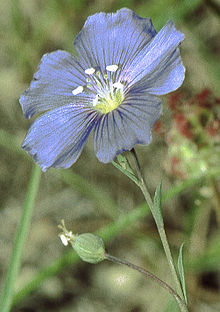Lothringer flax
| Lothringer flax | ||||||||||||
|---|---|---|---|---|---|---|---|---|---|---|---|---|

Lorraine flax ( Linum leonii ) |
||||||||||||
| Systematics | ||||||||||||
|
||||||||||||
| Scientific name | ||||||||||||
| Linum leonii | ||||||||||||
| FW Schulz |
The Lorraine flax ( Linum leonii ) is a very rare member of the linseed family (Linaceae) that only occurs in Central Europe . It blooms from May to July.
Appearance
The perennial herbaceous plant reaches a height of about 5 to 15 cm. The stem is initially prostrate, ascending at flowering time, then bent down again when the fruit is ripe, or lying and branched near the base. It is often meandering, dainty and arm-flowered (usually 1- to 6-flowered). The stem leaves are linearly shaped, very fine, smooth, approx. 0.5 to 2 mm wide and very close to the non-flowering shoots. The outer sepals are lanceolate to narrow-lanceolate, pointed, the inner ones are elongated-oval to ovate, about 3.5 to 6 mm long and also pointed short. The petals are usually bright blue, approx. 4 to 6 mm wide, 8 to 14 mm long and do not cover each other. The fruit stalks are bent to the side and not curved downwards. The capsules are about 5 to 7 mm long. The seeds are only weak and indistinctly blurred on the inner edge under the tip.
The number of chromosomes is 2n = 18.
distribution
Location requirements
Linum leonii grows in patchy dry grass. It prefers warm, nutrient-poor, lime-rich, stony loamy soils. He is a species of character of the order Brometalia.
General distribution
The Lothringer flax is extremely rare. It occurs only in central and northeastern France, as well as in central and southern Germany. There is also a population in Belgium (Van Rompaey et Devosalle 1979). The species is absent in Austria and Switzerland. It is a subatlantic floral element.
Distribution in Germany
Linum leonii occurs very rarely in Thuringia, the Harz foreland (northern limit of occurrence in the nature reserve Ziegenberg near Heimburg ), Hesse, southern Lower Saxony, the Taubertal and on the Moselle. It can also be found in the southern Eifel on the Keuperkuppen in the Nimstal.
Distribution in France
About 80% of the total deposits are in France. Most of them can be found in central (Paris Basin) and eastern France (Alsace-Lorraine).
Others
The Lorraine flax used to be regarded as a subspecies of the Alpine flax ( Linum alpinum ) together with the English linseed clan ( Linum anglicum ) occurring in England . According to current opinion, the forms occurring in England differ significantly from the French and West German. All clans are now treated as separate species.
While the Austrian flax ( Linum austriacum ) and the perennial flax ( Linum perenne ) with all their subspecies are largely self-sterile, the Lorraine flax is a self-pollinator and therefore does not depend on cross-pollination.
Species protection
Endangerment in Germany: Category 2: extremely endangered!
The species is particularly protected according to BArtSchV !
literature
- Henning Haeupler , Thomas Muer: picture atlas of the fern and flowering plants of Germany (= the fern and flowering plants of Germany. Volume 2). Published by the Federal Agency for Nature Conservation. Ulmer, Stuttgart 2000, ISBN 3-8001-3364-4 .
- Erich Oberdorfer : Plant-sociological excursion flora , Ulmer Verlag, Stuttgart, 1990, ISBN 3-8001-3454-3
- Christian August Friedrich Garcke : Illustrierte Flora , 1972, Paul Parey publishing house, ISBN 3-489-68034-0
Individual evidence
- ↑ a b Erich Oberdorfer : Plant-sociological excursion flora for Germany and neighboring areas . 8th edition. Verlag Eugen Ulmer, Stuttgart 2001, ISBN 3-8001-3131-5 . Page 632.
- ↑ State Administration Office of Saxony-Anhalt, Department for Nature Conservation and Landscape Management : Ziegenberg near Heimburg ( Memento of the original from April 25, 2012 in the Internet Archive ) Info: The archive link has been inserted automatically and has not yet been checked. Please check the original and archive link according to the instructions and then remove this notice. (Accessed March 17, 2007)
